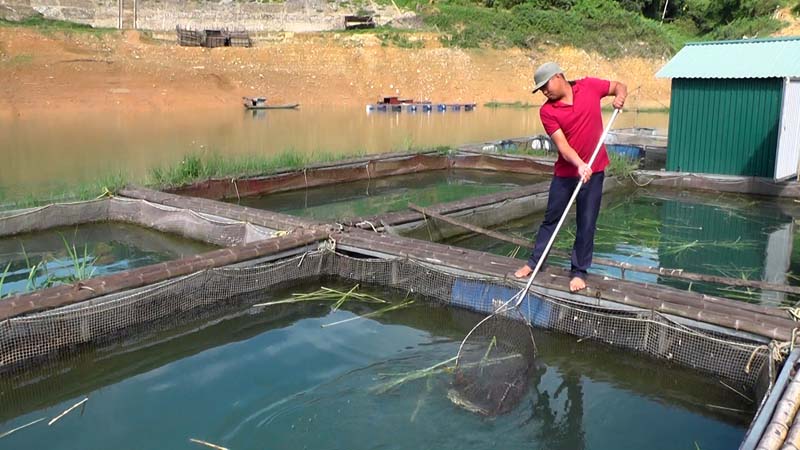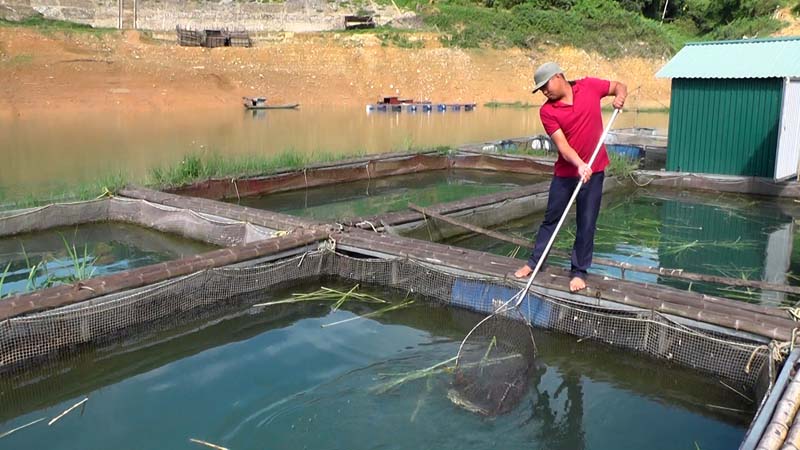
(HBO) - Tien Phong commune in Da Bac district has 10 out of the 12 hamlets
being located by the Hoa Binh lake which has rich and diverse aquatic resources.
Therefore, more than 300 households have focused on developing caged fish farming with over 800 cages.
 In 2018, Le
Dinh Hoi in Tup hamlet, Tien Phong commune, Da Bac district provided 6 tonnes
of fish to the market, earning 200 million VND in profit.
In 2018, Le
Dinh Hoi in Tup hamlet, Tien Phong commune, Da Bac district provided 6 tonnes
of fish to the market, earning 200 million VND in profit.
Caged fish farming was initiated in
the locality before 2000. However, as science and technology have not been
applied in the production process, and the consumption market is not stable, the
model has developed ineffectively.
From 2013, locals in Muc, Tup and Dieng hamlets has been focusing on developing
strongly caged fish farming models with varieties of Chien fish (Bagarius bagarius), Lang fish (Hemibagrus) and Tram den (Mylopharyngodon piceus). The profits from each cage developed effectively is estimated to be 20 - 30
million VND per year.
In order to encourage and support residents
in Tien Phong commune in particular, and those from other communes by the Hoa
Binh lake in general, the provincial People’s
Committee issued a decision on implementing policies to support caged fish
farming in the locality in the period of 2015 - 2020.
Accordingly, 142 local households have
been provided with 315 fish cages worth nearly 3 billion VND. In addition, the
commune has directed sectors and agencies to strengthen coordination in organising
training courses and transferring science and technology to attract the
participation of aquatic breeding households. Local people have been supported in accessing to preferential capital to expand
the model.
Xa
Van Thuc, Chairman of the communal People’s Committee, said per capita income
in the locality in 2018 reached 18 million VND, and the rate of poor households
was at 59.86 percent.
Therefore, the locality authorities have determined that caged fish farming is
a sustainable poverty reduction model to help local people improve their income
and promote poverty reduction.
Since the beginning of this year, under the direction of the Department of Agriculture and Environment, the Sub-Department of Agricultural, Forestry, and Fishery Product Quality Management has strengthened the integration of the professional activities to promote and guide the organizations and individuals in the production and trading of agricultural, forestry, and fishery products to comply with the legal regulations regarding the use of chemicals, pesticides and veterinary medicines in crop cultivation, livestock farming and aquaculture. They also provide guidance to processing and manufacturing establishments on keeping the records to trace the product origins and using food additives from the approved list according to the regulations.
Hoa Binh province saw a significant rise in state budget revenue in the first two months of 2025, heard a meeting chaired by Vice Chairman of the provincial People’s Committee Quach Tat Liem.
Ha Thi Ha Chi, a 26-year-old graduate in law, has taken an unconventional path by returning to her hometown in Mai Chau district to establish the Tong Dau Cooperative, creating stable jobs for local women and bringing Thai ethnic brocade weaving to the global market.
As the Lunar New Year 2025 approached, pork prices surged, creating a profitable season for farmers in Tan Vinh commune, Luong Son district. Taking advantage of the rising demand, Can Minh Son, a farmer from Coi hamlet, sold over 30 pigs at 69,000 VND/kg, each weighing more than 100 kg. After deducting expenses, his family earned a profit of over 50 million VND.
alternate member of the Central Party Committee, Secretary of the Hoa Binh provincial Party Committee Nguyen Phi Long on March 5 had a working session with Yan Jiehe, Founder and Chairman of the China Pacific Construction Group, one of China's largest private corporations in the field of transport infrastructure. Deputy Secretary of the provincial Party Committee, Chairman of the provincial People's Committee Bui Duc Hinh and leaders of provincial departments and sectors also attended the working session.
The electronic printed circuit board (PCB) manufacturing and processing plant of Japan’s Meiko Group, located at Da River Left Bank Industrial Park in Hoa Binh city with a total investment of over 200 million USD, is expected to create thousands of jobs and make a significant contribution to the local budget.



 In 2018, Le
Dinh Hoi in Tup hamlet, Tien Phong commune, Da Bac district provided 6 tonnes
of fish to the market, earning 200 million VND in profit.
In 2018, Le
Dinh Hoi in Tup hamlet, Tien Phong commune, Da Bac district provided 6 tonnes
of fish to the market, earning 200 million VND in profit.